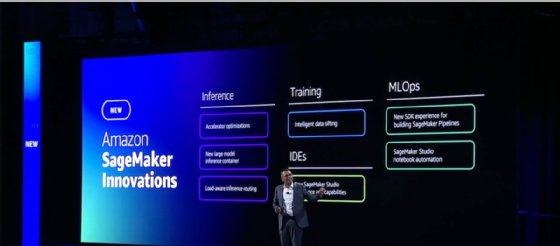AWS intros new GenAI tools for images and model training (original) (raw)
The tech giant's new image generator produces realistic images while also providing features for editing. SageMaker HyperPod helps reduce training times for foundation models.
AWS on Wednesday introduced the new Titan Image Generator model and Amazon SageMaker HyperPod, designed to reduce training times for foundation models.
Swami Sivasubramanian, vice president of data and machine learning at AWS, unveiled the generative AI products during a keynote on the third day of the tech giant's AWS re:Invent 2023 conference in Las Vegas.
The image generator model, part of AWS's family of Titan foundation models, enables customers to produce realistic images using natural language prompts, according to AWS. Meanwhile, SageMaker HyperPod helps users train machine learning models.
Titan Image Generator
With Titan Image Generator, AWS is targeting the advertising, e-commerce and media industries.
The system enables customers to automatically edit an image with text or a built-in segmentation model that divides customers in groups based on characteristics.
Titan Image Generator model is trained on a diverse set of data for accurate outputs, according to AWS. It also includes built-in mitigation capabilities for toxicity and bias. All the generated images also come with invisible watermarks.
"These watermarks are designed to help reduce the spread of misinformation by providing a discreet mechanism to identify AI-generated images," Sivasubramanian said during the keynote.
AWS is later to market with its image generator than the two of the most widely used generative AI-based image-creating systems. AWS' entry comes more than a year after OpenAI introduced Dall-E and months after Stability AI released Stable Diffusion.
The release doesn't seem to correlate to the cloud provider's mission of building products for customers, and it's not immediately clear where it fits into the vendor's portfolio, said Futurum Research analyst Mark Beccue.
"I'm not sure what their market position is on image generator," he said.
In another view, AWS's release of the image generator is a smart move, according to Forrester Research analyst William McKeon-White.
They seem to already have a fairly high number of features for a newly released image generator.
William McKeon-WhiteAnalyst, Forrester
Instead of just releasing a tool, the tech giant is already including editing features and other capabilities from similar products that are more mature in the market, McKeon-White said.
"They seem to already have a fairly high number of features for a newly released image generator," he said. For example, the new image generator supports inpainting of images, or reconstructing missing parts of an image, and outpainting to change or extend the image background.
However, the tech giant has yet to set itself apart much in image generation, he added.
"It's good AWS has a [product] here so that customers using them as a strategic provider don't need to look elsewhere, but I don't see anything incredibly differentiating yet," he said.
Pricing of the image generator is an advantage for AWS, McKeon-White noted.
AWS' prices are also lower than those of some big competitors. AWS cites its costs at 0.01perimage,lessthanDall−E3′s0.01 per image, less than Dall-E 3's 0.01perimage,lessthanDall−E3′s0.04 per image.
Titan Image Generator will be part of Amazon's selection in its foundation model service, Amazon Bedrock. It customers options among a group of third-party AI models, in addition to its own.
The tech giant also revealed a new Amazon Titan Multimodal Embeddings product. The embeddings help customers build better and contextually relevant multimodal search and recommendation experiences for end users, according to AWS.
Multimodal Embeddings can convert images and short English text of up to 128 tokens into embeddings. A token represents the length of a text. One token usually amounts to four characters or three-quarters of a word.
Multimodal Embeddings is generally available now in Bedrock.
Amazon also revealed that Anthropic's Claude 2.1 model, Stable Diffusion's XL 1.0 foundation model and Meta Llama 2 70B are generally available in Bedrock.
Bedrock also now supports batch inference, a process for users to process prompts in batches. Also in preview, Bedrock offers automatic evaluation of different foundation models.

Swami Sivasubramanian, vice president of data and machine learning at AWS, introduces new features in SageMaker.
Amazon HyperPod
Meanwhile HyperPod is a new technology for Amazon SageMaker, the vendor's machine learning service.
With HyperPod, users can reduce the time it takes to train foundation models, according to AWS.
HyperPod is preconfigured with SageMaker's distributed training libraries. It enables users' data and models to be distributed across thousands of chips in the cluster and process them in parallel, Amazon said.
It also checks for hardware failure and helps replace faulty instances.
HyperPod will be important if AWS' claims of reducing training time by 40% are accurate, Beccue said.
"If you think about what that might mean for customer, speed-to-market and cost, that's pretty significant," he said. "What's a differentiator for them is making this stuff go smoother for the customers, and that's a big deal."
SageMaker HyperPod is now generally available.
Amazon also introduced other SageMaker capabilities:
- SageMaker Inference enables customers to deploy different models to the same virtual server on AWS.
- SageMaker Clarify helps customers compare and evaluate different models for their use cases.
- SageMaker Canvas enhancements include two new launches in Canvas that make it easier and faster for users to integrate generative AI technology into their work.
Esther Ajao is a TechTarget Editorial news writer covering artificial intelligence software and systems.
Next Steps
Amazon's innovative generative AI moves at re:Invent 2023
 What is Amazon Bedrock (AWS Bedrock)? By: Cameron Hashemi-Pour
What is Amazon Bedrock (AWS Bedrock)? By: Cameron Hashemi-Pour  Amazon SageMaker, knows its onions
Amazon SageMaker, knows its onions  By: Adrian Bridgwater
By: Adrian Bridgwater  AWS re: Invent 2024: A ‘critical inflexion point’ for AI & data
AWS re: Invent 2024: A ‘critical inflexion point’ for AI & data  AWS reimagines SageMaker as suite for data, analytics, AI
AWS reimagines SageMaker as suite for data, analytics, AI  By: Eric Avidon
By: Eric Avidon